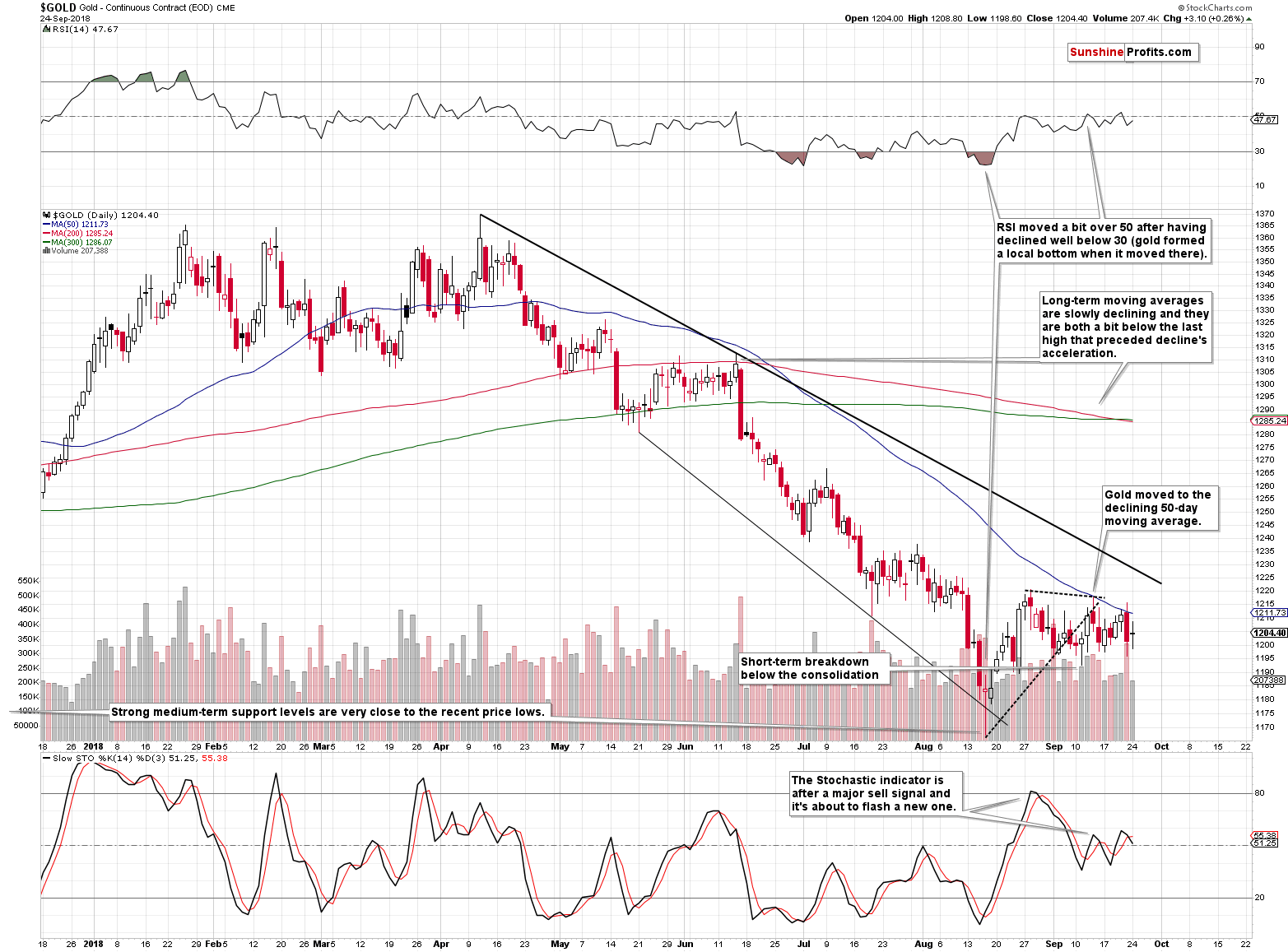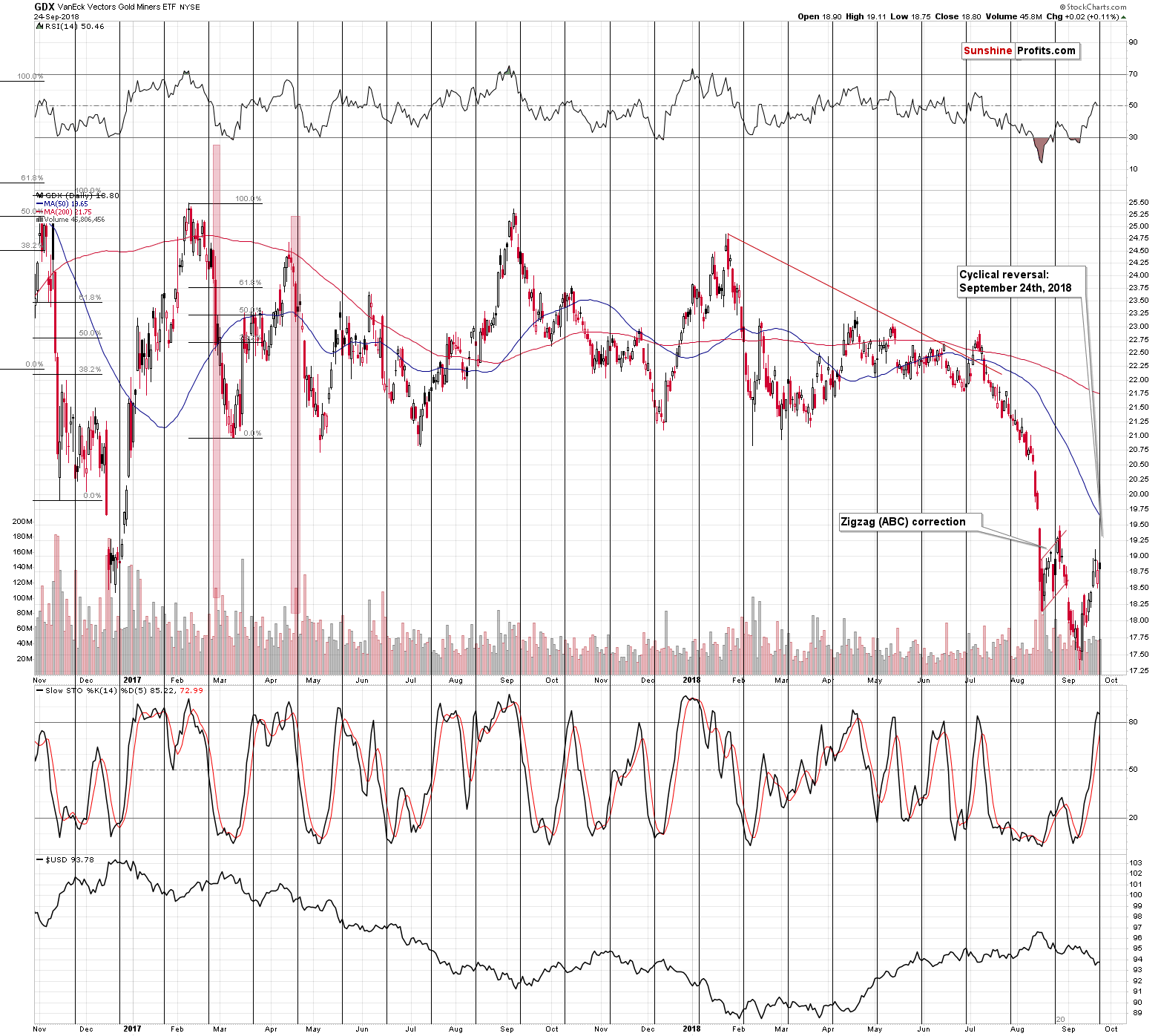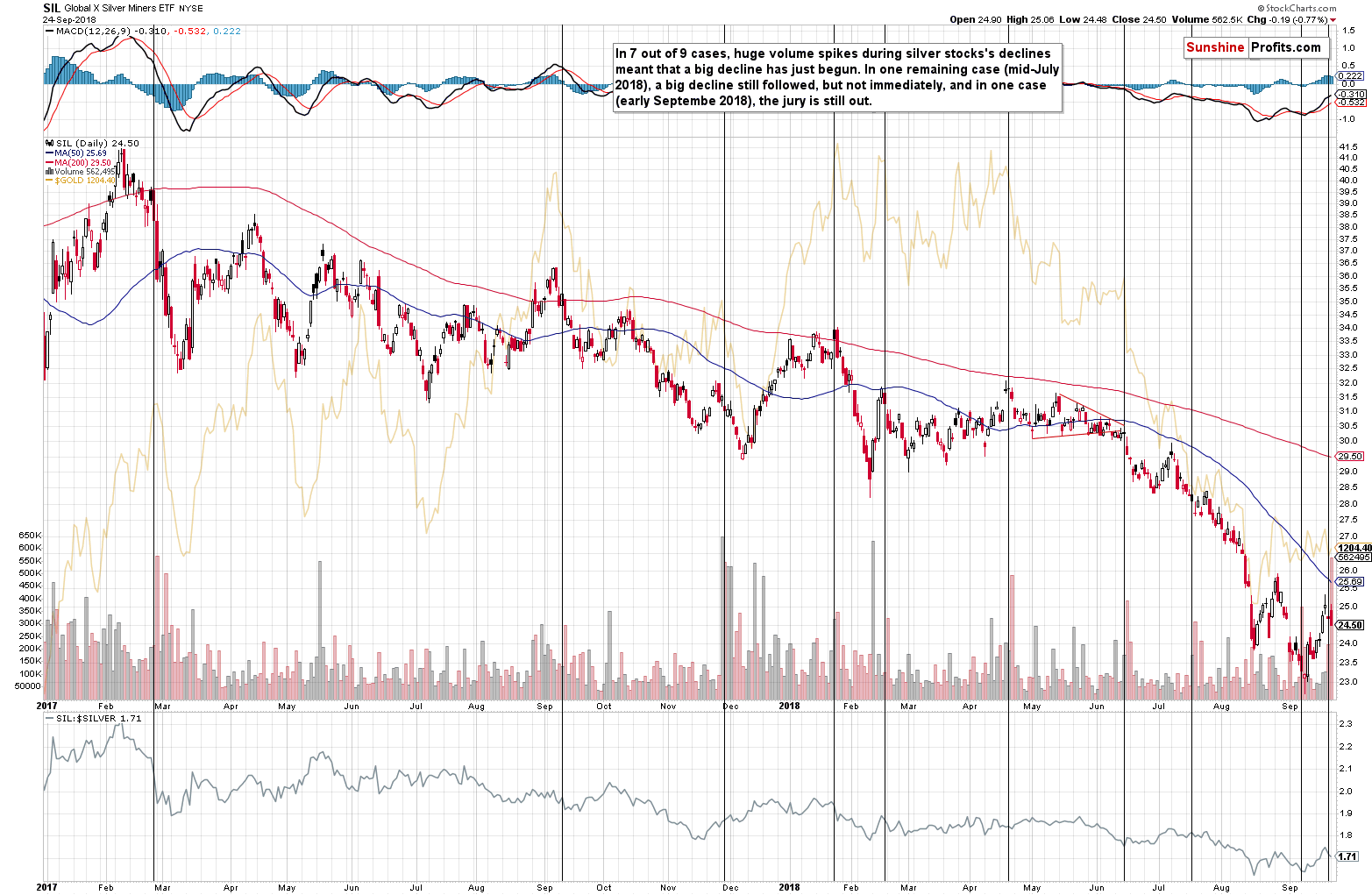Briefly: in our opinion, full (250% of the regular size of the position) speculative short positions in gold, silver and mining stocks are justified from the risk/reward perspective at the moment of publishing this alert.
Something happened yesterday on the precious metals market, and some things didn’t. Both are useful in predicting what’s likely to happen next in the PMs. Let’s start with what didn’t happen (charts courtesy of http://stockcharts.com).
No Changes in the Gold
Practically, nothing changed on the gold market yesterday and we can say the same thing about silver. The gold price moved back and forth on an intraday basis, but ended the session almost flat – only $3.10 higher.
For those, who haven’t been paying a lot of attention to what happened in the recent past and how it relates to the previous price movement, the above might be calming, boring or even somewhat disappointing. It might indicate that nothing is about to change, and we can take our guard down, while looking for more exciting opportunities elsewhere.
The key point here is that it’s the exact opposite of the truth.
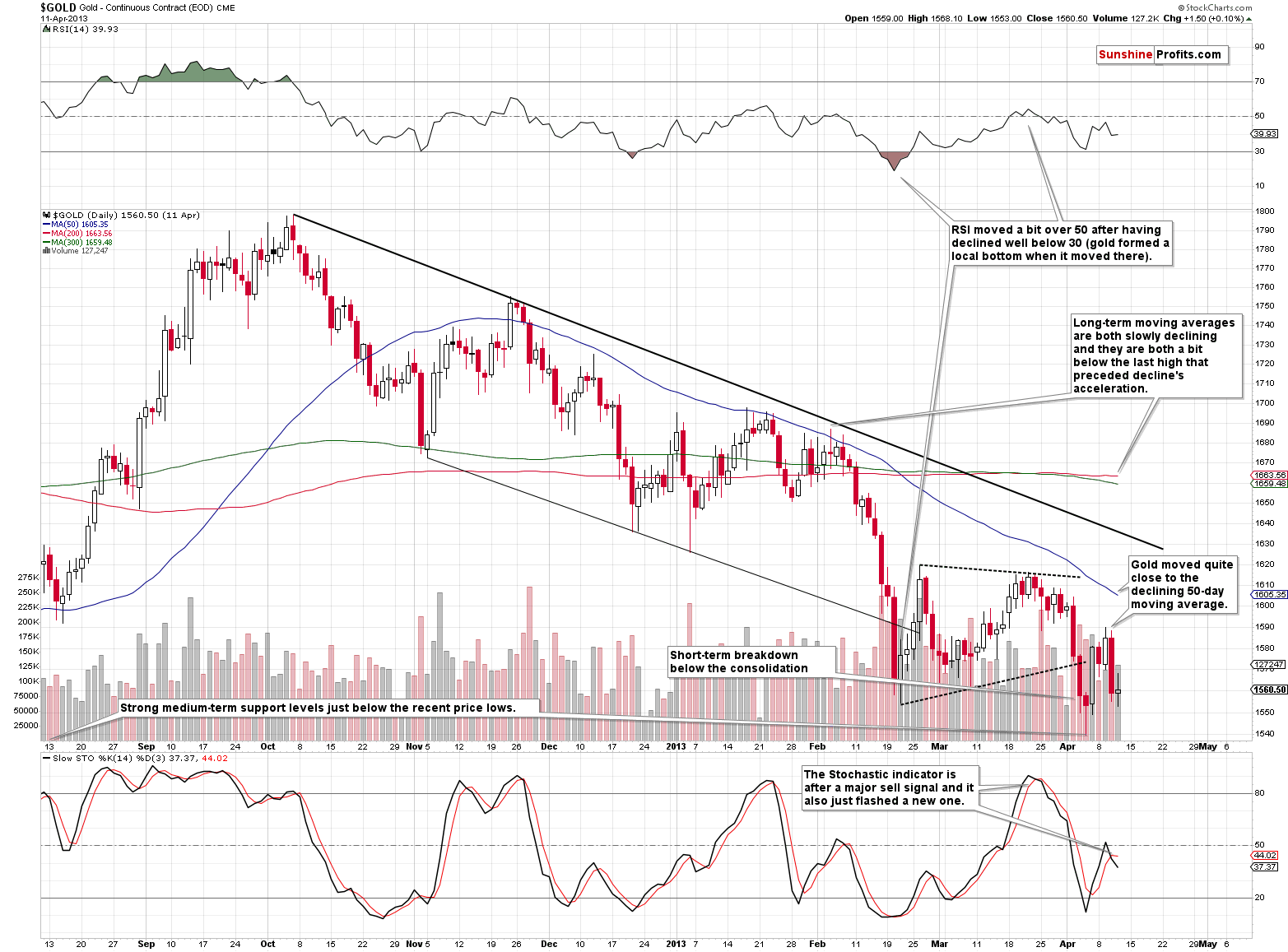
The above chart shows gold’s performance right before the huge 2-day slide that took it over $200 lower.
What did gold do on the final session right before the sudden slide? It did next to nothing. There was some back and forth movement and gold finally ended the session a bit higher ($1.50).
In the light of multiple similarities between the 2012-2013 decline and the current one, the daily pause that we saw right before the huge price slide, is the last thing that should make one put their guard down. In fact, that’s what is most likely to be seen before the next epic decline. The “calm before the storm” phrase may sound a bit cliché, but that’s exactly what we saw in 2013. And what we may see again.
Having discussed the implications of what didn’t happen, let’s move to what did happen.
Mining Stocks’ Reversal
Yesterday, was the mining stocks’ reversal date. And… Mining stocks reversed. Despite the intraday move higher, the GDX ETF closed almost unchanged ($0.02 upswing is next to nothing).
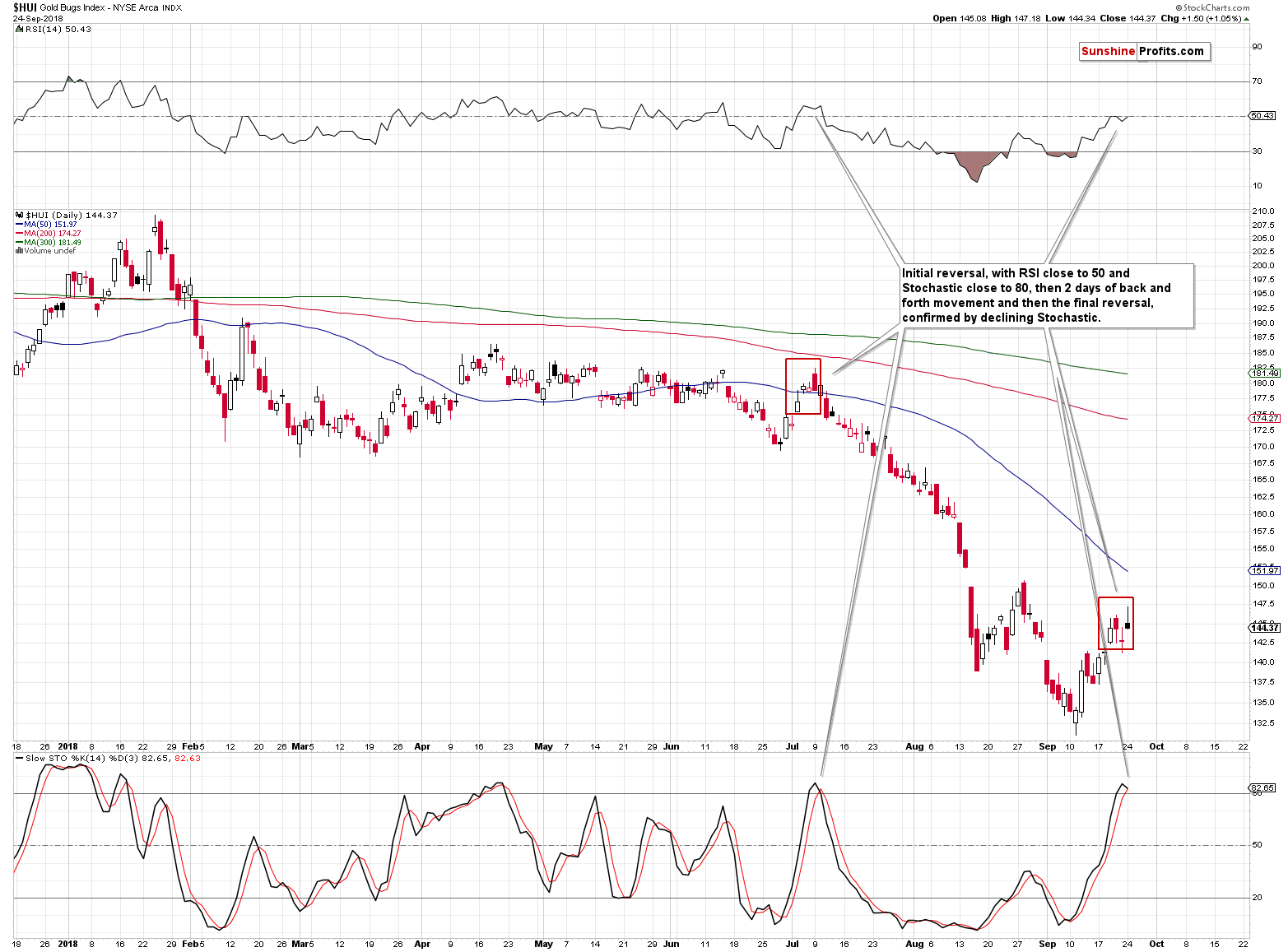
The HUI Index, closed more visibly higher, but it also formed a bearish shooting star candlestick, which made the technical picture more bearish, not bullish.
The most interesting thing that we see on the above chart, however, is the similarity to what happened in early July – right before the start of the current big decline.
There was an initial reversal, then 2 days of back and forth trading and then the final reversal. It was all accompanied by the RSI close to 50 and the final top was confirmed by a sell signal from the Stochastic indicator. And we have the same thing today as well. To be precise, the Stochastic didn’t flash the sell signal yet, but it already turned lower, so the sell signal will likely be seen after today’s session. Either way, the implications are bearish.
Silver Stocks’ Confirmation
The silver stocks have not only declined, but they have done so on huge volume. We marked similar cases with vertical lines. In almost all cases since the beginning of 2017, when we saw declines on huge volume in the SIL ETF, it meant that a big decline is about to begin or that it’s already underway. The signal was reliable not only for silver stocks, but also for the rest of the precious metals sector. You can see how gold performed – its price is in the background of the chart.
Yesterday’s volume was the biggest that we saw in many months, which confirms the strength of the signal. The implications are very bearish.
Before summarizing, we would like to quote the key parts of our previous Alerts, as they remain up-to-date and remain of utmost importance to those who have just joined our services. If you’ve read the following two sections, you can safely skip to the summary as there are no changes in them.
Research, Investment, and Results
We recently received quite a few questions about the use of specific financial instruments and what should one do if they owned them (for instance, specific type of options). We cannot provide investment advice, and unfortunately telling someone (specifically) what they should do with a given financial instrument falls under the definition of such advice. Consequently, instead of providing the above, we planned to discuss some of the issues through this publication that is not directed to just one person, but that is used to present our opinions in general terms. However, during the process of writing our reply, we digressed so much that the comments turned into something else – perhaps even more useful to you.
What we ended up creating, is the list of key factors that determine whether a given trade is successful or not. It may appear that the success of a given trade depends on just one factor – being correct about a given price move or not. But the reality is not that simple.
- The first thing is thorough research and this is what we are helping you with through our Alerts as this is something objective. The same research is useful for many investors and traders.
- The second thing is timing and that is also what we are helping you with. We’re keeping you up-to-date through our regular Alerts and through the occasional intraday follow-ups. Again, the timing-related Alerts are useful for many investors and traders.
- The
third thing is the choice of investment / trading vehicles. This is not
something objective and thus this is not something that we can choose
for you. At least not through a newsletter arrangement. Some investors
will be able to take on leverage as they are experienced in trading and
know that they are using capital that they can afford to lose. And some –
beginning investors and those who are using capital that they cannot
lose – should think at least twice before applying leverage. Some people
will prefer options because of the flexibility they provide, but some
will stick to traditional stock market purchases and sales. It all
depends on investor-specific factors. The key thing is that we can’t
tell you what you should choose, because that would be an investment
advice – which we can’t provide.
Naturally, in case of other arrangements, for instance through private investment fund or through managed futures trading and through private investment fund, we are able to manage the investment vehicles directly, but this is not possible through a newsletter.
Consequently, the choice of the investment / trading vehicle is yours to make. We can provide the information regarding various choices and we strive to explain their details etc., but the final call is up to you. For instance, we do the above by providing you with a list of investment / trading choices in general, an extensive list of ETFs, ETNs, several tools for choosing options: Position Size Calculator helps in choosing the expiration dates, the Pyramid Optimizer helps to choose the strike price, and the Option Calculator can help you make quick option pricing simulations. Speaking of options, in our opinion, it’s a good rule to give yourself at least (!) an extra month to any price/time prediction in order to lower the risk of options expiring before the price managed to move to its target. - The fourth thing is choosing the correct position size. Like above, this is something that we can do for our clients in case of the private investment fund and in case of the managed futures trading, but it’s not something that we can do through a newsletter. We strive to provide our thoughts in a way that makes it easier for you to make the decision regarding the position size (discussing the percentages of a regular size of a given position), but it will need to be you, who decides what the default position size can be. In this report you can read how important it is not to bet too much, and in this essay, you’ll see a simple simulation of what could happen if the position sizes are too big (it might be better to start with this one, and read the detailed pdf report later on). For general guidelines regarding the “trading capital”, and “investment capital”, please refer to our Gold & Silver Portfolio analysis. In the final part of that analysis, you’ll find pictures with sample portfolio structures for long-term investors, traders, and beginners. The rule of thumb is that if you can’t sleep well because of how big your position is, then it should be decreased by at least 30%. The same applies if you’re getting emotional about a given trade. For instance, we just saw a relatively small setback in profitability in case of the current short position - the profits on this single trade are multiple times greater than this year’s S&P 500 profits. If you got scared or emotional because of the above, it might be a good idea to limit the size of the position. Or have the trades managed professionally for you.
- The fifth thing is keeping in mind that trading and investment are processes that go well beyond a single trade. Moreover, there are developments of random nature and if one wants to make any money over time, one needs to accept that. Making all the research in the world, will not give you 100% certainty that something is going to happen or that it will happen exactly as you think. At times we will do everything correctly (points 1 and 2) and you will do everything correctly (points 3 and 4) and the trade will still end up being a losing trade. It’s natural and normal. For experienced investors and traders, it’s normal to the point that they are not even sad, angry, disappointed etc. by a trade that ended in the red. It’s just part of the process. As long as you’re making sure that all the previous points are taken care of and you’re striving to learn more about investments in general, it should all work out very well in the end. It’s important to keep that in mind as it should keep the emotions at bay, even during turbulent times. This, in turn is likely to lead to more objective, and thus better investment decisions. Not to mention better sleep and better health overall due to lower levels of stress.
Important Analyses
Before summarizing, we would like to emphasize that we have recently posted several analyses that are very important and that one should keep in mind, especially in the next several weeks. If you haven’t had the chance of reading them previously, we encourage you to do so today:
- Dear Gold Investor - Letters from 2013 - Analogy to 2013, which should make it easier to trade the upcoming sizable upswing (if enough factors point to it, that is) and to enter the market close to the final bottom.
- Gold to Soar Above $6,000 - discussion of gold’s long-term upside target of $6,000.
- Preparing for THE Bottom in Gold: Part 6 – What to Buy - extremely important analysis of the portfolio structure for the next huge, multi-year rally in the precious metals.
- Preparing for THE Bottom in Gold: Part 7 – Buy-and-hold on Steroids - description of a strategy dedicated to significantly boosting one’s long-term investment returns while staying invested in the PM sector.
- Gold’s Downside Target, Upcoming Rebound, and Miners’ Buy Plan - details regarding the shape of the following price moves, a buying plan for mining stocks, and a brief discussion of the final price targets for the current decline.
- Gold: What Happened vs. What Changed - discussion of the latest extreme readings from gold’s CoT report
- Key Factors for Gold & Silver Investors - discussion of key, long-term factors that support the bearish outlook for PMs. We are often asked what makes us so bearish – this article is a reply to this question.
- The Upcoming Silver Surprise - two sets of price targets for gold, silver and mining stocks: the initial and the final one.
- Precious Metals Sector: It’s 2013 All Over Again - comparison between 2013 and 2018 throughout the precious metals sector, the general stock market and the USD Index. Multiple similarities point to the repeat of a 2013-style volatile decline in the PMs.
Summary
Summing up, it seems that the next big downswing in the precious metals sector is already underway. The mining stocks seems to have reversed at their cyclical turning point and we saw additional bearish confirmation from the huge volume that accompanied yesterday’s decline in silver stocks. The daily pause in gold may appear boring, but please keep in mind that it was precisely what preceded the $200+ decline in gold in April, 2013. Consequently, seeing a pause now is definitely not a sign that the consolidation is going to continue for much longer.
The Fed’s next interest rate decision will be revealed tomorrow, so we may see an increase in volatility right before and/or right after it is announced. But, based on multiple signals that we already have, it seems that we are correctly positioned for what’s likely to come. It seems that the huge profits on our short positions will soon become enormous.
As always, we’ll keep you – our subscribers – informed.
To summarize:
Trading capital (supplementary part of the portfolio; our opinion): Full short positions (250% of the full position) in gold, silver and mining stocks are justified from the risk/reward perspective with the following stop-loss orders and exit profit-take price levels:
- Gold: profit-take exit price: $1,062; stop-loss: $1,226; initial target price for the DGLD ETN: $82.96; stop-loss for the DGLD ETN $53.67
- Silver: profit-take exit price: $12.72; stop-loss: $15.16; initial target price for the DSLV ETN: $46.97; stop-loss for the DSLV ETN $31.37
- Mining stocks (price levels for the GDX ETF): profit-take exit price: $13.12; stop-loss: $19.61; initial target price for the DUST ETF: $80.97; stop-loss for the DUST ETF $33.37
Note: the above is a specific preparation for a possible sudden price drop, it does not reflect the most likely outcome. You will find a more detailed explanation in our August 1 Alert. In case one wants to bet on junior mining stocks’ prices (we do not suggest doing so – we think senior mining stocks are more predictable in the case of short-term trades – if one wants to do it anyway, we provide the details), here are the stop-loss details and target prices:
- GDXJ ETF: profit-take exit price: $17.52; stop-loss: $29.43
- JDST ETF: initial target price: $154.97 stop-loss: $64.88
Long-term capital (core part of the portfolio; our opinion): No positions (in other words: cash)
Insurance capital (core part of the portfolio; our opinion): Full position
Important Details for New Subscribers
Whether you already subscribed or not, we encourage you to find out how to make the most of our alerts and read our replies to the most common alert-and-gold-trading-related-questions.
Please note that the in the trading section we describe the situation for the day that the alert is posted. In other words, it we are writing about a speculative position, it means that it is up-to-date on the day it was posted. We are also featuring the initial target prices, so that you can decide whether keeping a position on a given day is something that is in tune with your approach (some moves are too small for medium-term traders and some might appear too big for day-traders).
Plus, you might want to read why our stop-loss orders are usually relatively far from the current price.
Please note that a full position doesn’t mean using all of the capital for a given trade. You will find details on our thoughts on gold portfolio structuring in the Key Insights section on our website.
As a reminder – “initial target price” means exactly that – an “initial” one, it’s not a price level at which we suggest closing positions. If this becomes the case (like it did in the previous trade) we will refer to these levels as levels of exit orders (exactly as we’ve done previously). Stop-loss levels, however, are naturally not “initial”, but something that, in our opinion, might be entered as an order.
Since it is impossible to synchronize target prices and stop-loss levels for all the ETFs and ETNs with the main markets that we provide these levels for (gold, silver and mining stocks – the GDX ETF), the stop-loss levels and target prices for other ETNs and ETF (among other: UGLD, DGLD, USLV, DSLV, NUGT, DUST, JNUG, JDST) are provided as supplementary, and not as “final”. This means that if a stop-loss or a target level is reached for any of the “additional instruments” (DGLD for instance), but not for the “main instrument” (gold in this case), we will view positions in both gold and DGLD as still open and the stop-loss for DGLD would have to be moved lower. On the other hand, if gold moves to a stop-loss level but DGLD doesn’t, then we will view both positions (in gold and DGLD) as closed. In other words, since it’s not possible to be 100% certain that each related instrument moves to a given level when the underlying instrument does, we can’t provide levels that would be binding. The levels that we do provide are our best estimate of the levels that will correspond to the levels in the underlying assets, but it will be the underlying assets that one will need to focus on regarding the signs pointing to closing a given position or keeping it open. We might adjust the levels in the “additional instruments” without adjusting the levels in the “main instruments”, which will simply mean that we have improved our estimation of these levels, not that we changed our outlook on the markets. We are already working on a tool that would update these levels on a daily basis for the most popular ETFs, ETNs and individual mining stocks.
Our preferred ways to invest in and to trade gold along with the reasoning can be found in the how to buy gold section. Additionally, our preferred ETFs and ETNs can be found in our Gold & Silver ETF Ranking.
As a reminder, Gold & Silver Trading Alerts are posted before or on each trading day (we usually post them before the opening bell, but we don't promise doing that each day). If there's anything urgent, we will send you an additional small alert before posting the main one.
=====
Thank you.
Sincerely,
Przemyslaw Radomski, CFA
Founder, Editor-in-chief, Gold & Silver Fund Manager
Gold & Silver Trading Alerts
Forex Trading Alerts
Oil Investment Updates
Oil Trading Alerts


